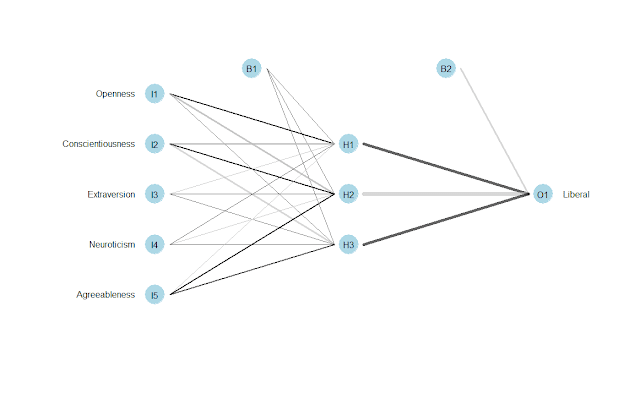Basic Three Layer Neural Network in Python
Introduction
As part of understanding neural networks I was reading Make Your Own Neural Network by Tariq Rashid. The book itself can be painful to work through, as it is written for a novice, not just in algorithms and data analysis, but also in programming. Although the code is a verbatim transcription from the text (see Source section), I published it to better understand how neural networks are designed, made easy by the use of a Jupyter Notebook, not to present this as my own work, although I do hope that this helps others develop their talents with data analytics.Github Source: AzureNotebooks/Basic Three Layer Neural Network in Python.ipynb at master · JamesIgoe/AzureNotebooks (github.com)
Overview
The code itself develops as follows:Constructor
- set number of nodes in each input, hidden, output layer
- link weight matrices, wih and who
- weights inside the arrays are w_i_j, where link is from node i to node j in the next layer
- set learning rate
- activation function is the sigmoid function
Define the Training Function
- convert inputs list to 2d array
- calculate signals into hidden layer
- calculate the signals emerging from hidden layer
- calculate signals into final output layer
- calculate the signals emerging from final output layer
- output layer error is the (target actual)
- hidden layer error is the output_errors, split by weights, recombined at hidden nodes
- update the weights for the links between the hidden and output layers
- update the weights for the links between the input and hidden layers
Define the Query Function
- convert inputs list to 2d array
- calculate signals into hidden layer
- calculate the signals emerging from hidden layer
- calculate signals into final output layer
- calculate the signals emerging from final output layer
Load Libraries
# for scientific computing with Python
import numpy
# for the sigmoid function expit()
import scipy.special
Develop Neural Network Class
#neural network class definition
class neuralNetwork:
# for scientific computing with Python
import numpy
# for the sigmoid function expit()
import scipy.special
#initialise the neural network
def __init__(self, inputnodes, hiddennodes, outputnodes, learningrate):
#set number of nodes in each input, hidden, output layer
self.inodes = inputnodes
self.hnodes = hiddennodes
self.onodes = outputnodes
#link weight matrices, wih and who
#weights inside the arrays are w_i_j, where link is from node i to node j in the next layer
#w11 w21
#w12 w22 etc
self.wih = numpy.random.normal(0.0, pow(self.hnodes, -0.5), (self.hnodes, self.inodes))
self.who = numpy.random.normal(0.0, pow(self.onodes, -0.5), (self.onodes, self.hnodes))
#learning rate
self.lr = learningrate
#activation function is the sigmoid function
self.activation_function = lambda x: scipy.special.expit(x)
pass
#train the neural network
def train(self, inputs_list, targets_list):
#convert inputs list to 2d array
inputs = numpy.array(inputs_list, ndmin=2).T
targets = numpy.array(targets_list, ndmin=2).T
#calculate signals into hidden layer
hidden_inputs = numpy.dot(self.wih, inputs)
#calculate the signals emerging from hidden layer
hidden_outputs = self.activation_function(hidden_inputs)
#calculate signals into final output layer
final_inputs = numpy.dot(self.who, hidden_outputs)
#calculate the signals emerging from final output layer
final_outputs = self.activation_function(final_inputs)
#output layer error is the (target actual)
output_errors = targets - final_outputs
#hidden layer error is the output_errors, split by weights, recombined at hidden nodes
hidden_errors = numpy.dot(self.who.T, output_errors)
#update the weights for the links between the hidden and output layers
self.who += self.lr * numpy.dot((output_errors * final_outputs * (1.0 - final_outputs)), numpy.transpose(hidden_outputs))
#update the weights for the links between the input and hidden layers
self.wih += self.lr * numpy.dot((hidden_errors * hidden_outputs * (1.0 - hidden_outputs)), numpy.transpose(inputs))
pass
#query the neural network
def query(self, inputs_list):
#convert inputs list to 2d array
inputs = numpy.array(inputs_list, ndmin=2).T
#calculate signals into hidden layer
hidden_inputs = numpy.dot(self.wih, inputs)
#calculate the signals emerging from hidden layer
hidden_outputs = self.activation_function(hidden_inputs)
#calculate signals into final output layer
final_inputs = numpy.dot(self.who, hidden_outputs)
#calculate the signals emerging from final output layer
final_outputs = self.activation_function(final_inputs)
return final_outputs
Run and Output the Result
nn = neuralNetwork(3, 3, 3, .5)
nn.train([1.0, 0.5, -1.5], [1.0, 0.5, -1.5])
nn.query([1.0, 0.5, -1.5])
array([[ 0.4353349 ],
[ 0.64146723],
[ 0.3650745 ]])
Source
Tariq's GitHub: Code for the Make Your Own Neural Network BookBook: Make Your Own Neural Network by Tariq Rashid: Make Your Own Neural Network (GoodReads)



Comments
Post a Comment